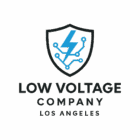What Are Low Voltage Systems for Homes? A Complete Guide for Homeowners
Introduction
When most homeowners think about electricity, they picture standard outlets powering appliances, TVs, and computers. But not all electrical systems in your home run on high voltage. Low voltage systems—those operating at 50 volts (V) or less—play a crucial role in modern residential infrastructure. From security cameras and doorbells to landscape lighting and home automation, these systems enhance comfort, safety, and efficiency.
In this guide, we’ll break down what low voltage systems are, how they work in homes, their advantages, and what you should know as a homeowner in today’s increasingly smart, connected world.
At Los Angeles Low Voltage Company, we design and install customized low-voltage systems to improve safety, efficiency, and convenience in your home.
Table of Contents
- What Are Low Voltage Systems?
- Examples of Low Voltage Systems in Homes
- How Low Voltage Differs from Line Voltage
- Benefits of Low Voltage Systems for Homeowners
- Safety Considerations of Low Voltage
- Common Issues and Troubleshooting
- Future Trends in Low Voltage Home Technology
- Conclusion
- FAQs
What Are Low Voltage Systems?
Low voltage systems are electrical systems that operate at 50 volts or less, typically using 12V, 24V, or 48V power sources. They are designed for specialized functions rather than powering heavy-duty appliances.
According to the National Electrical Code (NEC), low voltage wiring is often referred to as Class 2 or Class 3 wiring, which requires different installation standards than high-voltage (line voltage) systems.
These systems are integral to:
- Security and safety (alarms, cameras, fire alarms)
- Convenience (smart home automation, intercoms, Wi-Fi cabling)
- Aesthetics (landscape and accent lighting)
Examples of Low Voltage Systems in Homes
Here are the most common low voltage systems you’ll find in residential settings:
Security Systems
- CCTV cameras
- Video doorbells
- Motion detectors
- Alarm systems
Home Networking & Communication
- Ethernet cabling (Cat5e, Cat6)
- Phone lines
- Intercom systems
- Wi-Fi access points
Lighting
- Landscape lighting (pathway, garden, accent)
- Under-cabinet and recessed lighting
- LED low-voltage strips
Smart Home Devices
- Thermostats
- Smart locks
- Voice assistants
- Automated blinds
Audio-Visual Systems
- Home theater wiring
- Whole-home audio
- HDMI distribution
How Low Voltage Differs from Line Voltage
The primary difference lies in power and safety:
- Line Voltage (120/240V in the U.S.)
- Powers refrigerators, ovens, HVAC systems
- Requires licensed electricians for installation
- Higher risk of electric shock
- Low Voltage (≤50V)
- Powers lights, alarms, communication systems
- Often safer and more energy-efficient
- Can sometimes be installed by homeowners with proper kits
Benefits of Low Voltage Systems for Homeowners
- Energy Efficiency – Low voltage LED lighting uses up to 80% less energy than traditional bulbs.
- Safety – Reduced risk of electric shock and fire hazards.
- Flexibility – Easier to install and expand, especially in smart homes.
- Cost Savings – Lower energy bills and often cheaper wiring installation.
- Smart Home Integration – Works seamlessly with IoT (Internet of Things) devices.
Safety Considerations of Low Voltage
While safer than high-voltage systems, low voltage wiring is not risk-free. Poor installation can cause:
- Short circuits
- Fire risks (especially with overloaded transformers)
- Interference with Wi-Fi or signals
⚡ Pro Tip: Always hire a licensed low voltage contractor for large-scale installations to comply with local electrical codes.
Common Issues and Troubleshooting
Homeowners may face:
- Dimming or flickering lights (loose connections or failing transformers)
- Weak Wi-Fi signals (improper cabling or interference)
- False alarms in security systems (faulty sensors)
🛠️ Solution: Routine maintenance and professional inspections can prevent these issues.
Future Trends in Low Voltage Home Technology
The low voltage sector is evolving quickly:
- PoE (Power over Ethernet): Allows devices like cameras and access points to receive both power and data through one cable.
- Smart Grid Integration: Homes will increasingly tie into energy-efficient smart grids.
- AI & Automation: Security and smart home systems powered by AI for enhanced customization.
- Wireless Low Voltage Systems: Growth of battery-powered and solar-integrated devices.
Many homeowners wonder if everyday electronics can run on these systems. For instance, you can learn more about charging your phone with low voltage and how it works.
Conclusion
Low voltage systems are the unsung heroes of modern homes. They power the security, comfort, and smart features we rely on daily—all while saving energy and reducing risks. Whether you’re planning a new build, upgrading your home, or integrating smart technology, understanding low voltage systems will help you make informed decisions and future-proof your living space.
